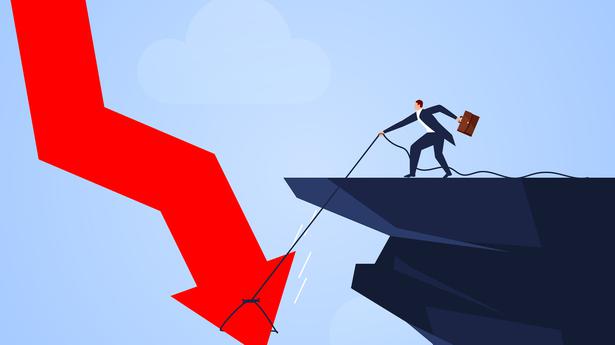
Explained | How are fears of stagflation impacting markets?
Will inflationary shocks and supply side constraints due to the Ukraine war lead to more challenges?
Will inflationary shocks and supply side constraints due to the Ukraine war lead to more challenges?
The story so far: Authorities worldwide, particularly central bankers, are feverishly trying to formulate the appropriate set of policies to ensure that inflation, currently running at multi-decade highs in some advanced economies including the U.S., is cooled without triggering a recession. Former Federal Reserve Chairman Ben Bernanke told The New York Timeslast month that he foresaw a period in the near future “where growth is low, unemployment is at least up a little bit and inflation is still high”, adding, “So you could call that stagflation”.
What exactly is stagflation?
Most economists typically focus on the three key macroeconomic gauges to assess the health of an economy. Economic output measured by gross domestic product, the level of unemployment and thirdly inflation or the pace at which the prices of goods and services are rising in the economy.
Editorial | Global stagflation risk: On the need to cut fuel taxes
The challenge for policymakers, especially central banks, is to ensure optimum conditions whereby output grows at a healthy pace, helping businesses in the economy to create jobs at a steady pace and thus keeping unemployment low, and most crucially having all of this happen in an atmosphere when prices remain relatively stable.
However, in the real world, more often than not, high economic growth invariably spurs faster inflation which is why many central banks have a specific mandate of ensuring that the pace of price gains does not exceed a specified target level or range.
The most difficult and messy problem for policymakers is when inflation runs high even as economic output either stagnates or, worse, shrinks. The slowdown in economic activity, in turn, leads businesses to shed jobs and the resultant situation is termed as ‘stagflation’.
How does it manifest?
One of the classic instances when most economies including the U.S. faced ‘stagflation’ was during the ‘oil shock’ of the early 1970s when an embargo led by the oil producers’ cartel OPEC caused the price of crude to almost quadruple in a period of just under six months.
“Countries like the U.S. that imported a lot of oil experienced both high inflation and recession,” Veronika Dolar, an Assistant Professor of Economics at SUNY Old Westbury in the U.S., wrote in an article published by the online journal The Conversation in March. “The Consumer Price Index exceeded 10% for the first time since the 1940s, unemployment jumped from 4.6% in 1973 to 9% in 1975, and the GDP plunged,” she observed.
What has sparked the latest concerns about stagflation?
While the outbreak of the COVID-19 pandemic and the curbs imposed to contain the spread of the virus caused the first major recent economic slowdown worldwide, the subsequent fiscal and monetary measures taken to address the downturn, including substantial increases in liquidity in most of the advanced economies, fuelled a sharp upsurge in inflation.
While the Fed and the Bank of England are among central banks that have started raising interest rates to cool soaring prices, the ongoing war in Ukraine following Russia’s invasion of its southern neighbour and the consequent Western sanctions on Moscow have caused a fresh and as yet hard-to-quantify ‘supply shock’.
With the prices of commodities ranging from oil and gas to foodgrains, edible oils and fertilizers all surging sharply in the wake of the conflict, authorities face an uphill battle to contain inflation that is now less a function of demand (and so can be controlled by regulating credit) and almost entirely caused by supply factors that are far harder to manage.
To add to the concerns, several business leaders including Tesla’s Elon Musk and JP Morgan Chase & Co.’s Jamie Dimon are warning of an impending ‘recession’.
What lies ahead?
Current Fed Chairman Jerome Powell summed it last month at the post-federal open market committee press conference when asked if a recession was inevitable to tame inflation. “Basically, we’ve been hit by historically large inflationary shocks since the pandemic. This isn’t anything like regular business… it’s been a series of inflationary shocks that are really different from anything people have seen in 40 years. So we have to look through that and look at the economy that’s coming out the other side. And we need to somehow find price stability out of this. And it’s obviously going to be very challenging.”
Stay connected with us on social media platform for instant update click here to join our Twitter, & Facebook
We are now on Telegram. Click here to join our channel (@TechiUpdate) and stay updated with the latest Technology headlines.
For all the latest Education News Click Here
For the latest news and updates, follow us on Google News.

